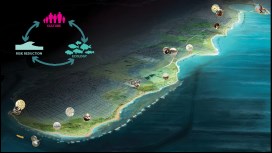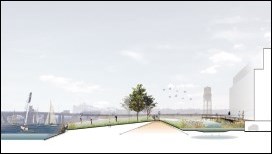by Shane Henson — June 18, 2014—The U.S. Department of Housing and Urban Development (HUD) recently announced that six design proposals have been selected as winners of its Rebuild by Design competition, an initiative launched in the summer of 2013 by President Obama’s Hurricane Sandy Rebuilding Task Force as a way to develop ideas capable of dramatically improving the physical, ecological, and economic resilience of coastal areas.
HUD says it is allocating approximately $920 million to New York, New Jersey, and New York City to begin implementation of the winning projects that will make the region more environmentally and economically resilient. This funding was included in HUD’s most recent allocation of approximately $2.5 billion in Community Development Block Grants—Disaster Recovery for the Sandy region.
The winning proposals come from six interdisciplinary teams representing some of the best planning, design, and engineering talent in the world. These inventive proposals are a blueprint for how communities can maximize resilience as they rebuild and recover from major disasters. HUD says it chose the winners for their excellence in design and resilience and their engagement with local communities.
The six teams with winning proposals are:
- The BIG Team—The BIG U (East River Park)—Manhattan: The BIG proposal presents a protective system around Manhattan’s edge. It protects 10 continuous miles of low-lying geography that comprise an incredibly dense, vibrant, and vulnerable urban area. The proposed system not only shields the city against floods and stormwater, it also creates and provides social and environmental benefits to the community through an improved public realm.
- SCAPE/Landscape Architecture—Living Breakwaters—Tottenville, Staten Island: Funding for the Scape proposal is to build out the entire Tottenville section of the Living Breakwaters project, which will reduce risk, revive ecologies, and connect educators and local students to the shoreline, inspiring a new generation of harbor stewards and a more resilient region over time. The in-water solution will reduce wave action and erosion, lowering risk from heavy storms by designing “reef street” micropockets of habitat complexity to host finfish, shellfish, and lobsters. The proposal examines how and where it can most effectively protect communities. This living infrastructure will be paired with social resiliency frameworks in adjacent neighborhoods.
- The Interboro Team—Living With the Bay (Slow Streams)—Nassau County, Long Island:The Interboro teams proposal presents a comprehensive, regional resiliency plan for Nassau County’s South Shore. The plan consists of a variety of elements that provide a range of integrated adaptive measures that keep Nassau County residents safe, while adding to the economic, ecological, and social quality of the region.
- OMA—Resist, Delay, Store, Discharge—Hoboken, Weehawken, Jersey City:The comprehensive urban water strategy developed by the OMA Team provides protection along all of the Hoboken waterfront and parts of Weehawken and Jersey City. It deploys programmed hard infrastructure and soft landscape for coastal defense (resist); policy recommendations, guidelines, and urban infrastructure to slow rainwater runoff (delay); a circuit of interconnected green infrastructure to store and direct excess rainwater (store); and water pumps and alternative routes to support drainage (discharge). The objectives are to manage water for both severe storms and long-term growth, enable reasonable flood insurance premiums through the potential redrawing of the FEMA flood zone following completion, and deliver co-benefits that enhance the cities and the region.
- MIT CAU+ZUS+URBANISTEN— New Meadowlands— Little Ferry, Moonachie, Carlstadt, and Teterboro: The New Meadowlands project articulates an integrated vision for protecting, connecting, and growing this critical asset to both New Jersey and the metropolitan area of New York. The first phase of their proposal focuses on Little Ferry, Moonachie, Carlstadt, and Teterboro. By integrating transportation, ecology, and development, the project transforms the Meadowlands basin to address a wide spectrum of risks, while providing civic amenities and creating opportunities for new redevelopment.
- PennDesign/OLIN—Lifelines—Hunts Point, South Bronx: Hunts Point is the hub of the region’s food supply chain and a local living-wage employment center in the poorest congressional district in the country. The PennDesign/OLIN proposal sets out four strategies: integrated and adaptable flood protection systems to safeguard the whole neighborhood and create public amenities along the Hunts Point waterfront; leadership efforts to build capacity for social resilience; a marine emergency supply chain to enhance the waterways as critical infrastructure; and cleanways to improve air quality.







